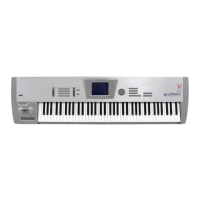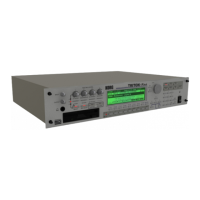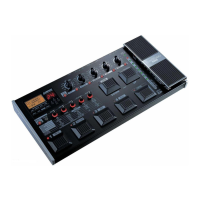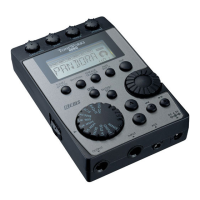MIDI Implementation
184
Using MIDI exclusive messages
Unlike normal general-purpose messages, exclusive messages can be used by each manufacturer
in any desired way, and are used mainly for exchanging sound data.
The format will differ between manufacturers, but Korg’s own format is as follows.
The ‘model ID’ in the 4th byte specifies the model for whom the message is intended, but since all
models of the Trinity series use the same model ID, exclusive messages can be exchanged between
any of these instruments. In addition, a ‘member code’ can be used to query further subdivisions
of instruments with the same model ID. (Refer to 1–4 Universal System Exclusive Messages.)
The function of the exclusive message is determined by the 5th byte; the function ID. For the vari-
ous types, refer to the Function Code List (1–5, 2–6).
Transmission or reception of a set of sound data etc. is referred to as a data dump. This can be
transmitted in the Global mode Data Dump page, or in response to an appropriate Request mes-
sage being received.
Notes for each type of message
• No.11 Program Write Request
This message writes the program in the edit buffer into internal memory. When you enter Pro-
gram Edit mode, the data for that program is loaded into the edit buffer (the writing source), so
it is recommended that it be written in Program Edit mode. It is also possible to write in Pro-
gram Play mode, but even in this case, correct writing is possible only by going through Pro-
gram Edit mode.
• No.41 Parameter Change, No.53 Drum Parameter Change, No.4E Mode Change
When the mode is changed from the front panel of the Trinity, a “Mode Change” message is
transmitted. Each time a parameter is selected or a value is modified in Program Play (Perfor-
mance Edit), Program Edit, or Combination Edit, a “Parameter Change” message is transmit-
ted. By transmitting these messages to the Trinity, parameters can be edited individually. The
“Parameter Change” contains the mode data, so if the mode of the receiving instrument does
not match, that “Parameter Change” will not be received (i.e., that mode data will not change
the mode).
In Global mode, only drum kit parameters can be changed individually, and “Drum Parameter
Change” messages are used for this purpose. The method is the same as for “Parameter
Change” messages.
• When an exclusive message has been received and its data has been processed, a “Data Load
Completed” (ACK) message is transmitted. However if the received data was in an incorrect
format, a “Format Error” message will be transmitted, and if the receiving Trinity series instru-
ment was set inappropriately (for example if memory protect was turned on, or if the mode
was wrong), a “Load Error” (NAC) message will be transmitted.
If a program change message is received when the Exclusive Filter is set to ENA, a “Data Load
Completed” message will be transmitted after the message has been processed. (Program
Change messages are not exclusive messages, but this is an exception.)
1st byte ‘F0’ : exclusive status
2nd byte ‘42’ : Korg ID
3rd byte ‘3n’ : n (0–F) is the Global MIDI channel 1–16
4th byte ‘3B’ : model ID (3B: TRINITY series)
5th byte ‘ff’ : function ID (the function etc. of the data in the 6th and following bytes)
6th and following : data
last byte ‘F7’ : end of exclusive
…
…

